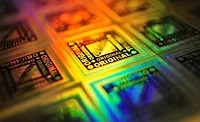TECH FLASH
Smart packaging multi-tasks to engage consumers and fight counterfeiting
Brand integrity and customer engagement are essential.
As food manufacturers seek to provide innovative and high-quality products, it is critical for them to engage consumers in exciting ways while protecting the integrity of the brand. Both initiatives make a case for smart packaging, and many industry players are catching on. According to a report published earlier this year by The Freedonia Group, demand for smart packaging is expected to grow by 8 percent annually, reaching sales of $3.5 billion in the United States by 2017.
At PACK EXPO International 2014 (McCormick Place, Chicago; Nov. 2-5), food manufacturers will be able to explore the latest packaging technologies and insights to advance their brands with smart packaging. To shed some light on this trend, we spoke with Tom Egan from PMMI, The Association for Packaging and Processing Technologies, the owner and producer of the PACK EXPO family of trade shows.
FE:When we think of smart packaging, many applications come to mind. How are brands using these technologies to attract and engage consumers?
Egan:Many companies are utilizing smart packaging to establish a stronger relationship between brands and end-users. Take the Häagen-Dazs Concerto Timer app as an example. The makers of Häagen-Dazs know ice cream is best when it is allowed to warm up just a bit after being removed from a home freezer. Customers with the app on their smartphones can scan a QR code on the package lid and, through the use of augmented reality (AR), enjoy a two-minute mini-concert, while their ice cream reaches the ideal temperature. On their screens, consumers will see a tiny violinist on the lid of the ice cream carton playing Bach Invention No. 14. Once the concert is over, the ice cream is ready to enjoy. Could Häagen-Dazs simply have included a recommended wait time on the label? Absolutely, but this interactive packaging initiative takes consumer engagement to the next level.
Smart packaging can also be used to indicate whether a product is fresh and ready for consumption or nearing expiration. For instance, some poultry manufacturers are using freshness indicators on labels that change color as the product’s end-of-sale-date approaches. Time-temperature indicators also allow producers, retailers and consumers to tell whether perishable products have been properly transported and stored.
FE:How is smart packaging being used to protect consumers from counterfeit goods?
Egan: Product safety and brand integrity are critical to ensuring a positive consumer experience. For many manufacturers, counterfeiters pose significant challenges to their bottom line. The Department of Homeland Security reported that the value of seizures in terms of the manufacturers’ suggested retail price was over $1.7 billion for the 2013 Fiscal Year in the US alone. Poor-quality counterfeit products affect more than profit margins; they can also harm consumers and irreparably damage the reputation of a brand in the process.
New printing and labeling techniques, security holograms and other technologies falling under the smart packaging umbrella can help brand owners protect consumers from inferior, counterfeit products. For example, security holograms, which are coded authentication seals, can track products throughout the distribution chain and serve as an indicator of authenticity to retailers and consumers.
FE:How can food manufacturers find the right smart packaging solutions for their operations?
Egan:To find smart packaging solutions that enhance the consumer experience and mitigate issues associated with counterfeiters, brand owners can look to PACK EXPO International 2014, to be held November 2-5; McCormick Place, Chicago, IL. The show will also feature the third Active & Intelligent Packaging Industry Association (AIPIA) World Congress. The event will feature conference sessions that address cutting-edge solutions for active and intelligent packaging.
To register for PACK EXPO International 2014, visit packexpointernational.com. Registration is $30 prior to October 3, 2014 and $60 thereafter.
Looking for a reprint of this article?
From high-res PDFs to custom plaques, order your copy today!






